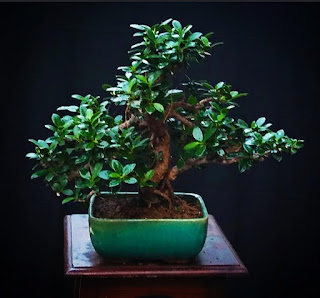By Vandana
Ficus green island is a variety of Ficus Micrpcarpa. It is a tropical evergreen shrub. It grows to a height of 2.4 to 3 metres with a canopy of .9 to 1.2 metres wide.
Its origin is India ,Sri Lanks, Southern China, Malasia, Borneo.
It’s a Family of Moraceae
LEAVES : they are glossy dark green leathery small and round. Young leaves are yellow green and turn dark as they mature. The shape would be described botanically as orbicular with only an obscure lip.
TRUNK : New shoots and very young stems are green and turn brown as they mature. The stems are naturally thick and strong and they can grow upto a diameter of 5 cms. The trunk is the most mature part and is brown to light grey . It can grow upto 7 cms in diameter.
FLOWERS AND FRUITS : The flowers are inside what we think young fruit and the colour is white or cream yellow . Fruit is green with an accent of purple when young and turn purple when ripe.
ROOTS : Young aerial roots are white and turn red to brown .It is said the root system is twice as large and deep as its canopy.
WATERING: Green Island can tolerate under watering to over watering but no water logging . The top soil is dry to 1 cm then it needs to be watered.
LIGHTING : It can adapt to low medium or high light . Long exposure to direct sunlight can cause yellowing of leaf
FERTILIZING : It can be fertilized every two weeks in summer and four to six weeks in winter.
PRUNING : Pruning encourages the growth of young stems and branches .We can prune stems , twigs, and leaves for new shoots .Leaf pruning can be used to reduce leaf size . Pruning can be done 2 ways , either constant or seasonal.
PESTS : Common pests are scale insects and mealy bugs . They can cause leaf yellowing and leaf drop .They can be removed by hand or cotton swabs with alcohol.
PROPOGATION : Propogation is possible with root cutting or by stem cutting . Dip the cutting in root hormone and plant it in a container . Do not cover with plastic. Keep it near the window and watered. Within a few weeks cuttings will take root .Early summer is the best time.
WIRING : Plant must be shaped and wired early. Check the wired branches frequently . The plant is prone to growth spurts during the growing season so scars and cuts can happen in the bark very quickly.
REPOTTING : It must be potted once every two years . It all depends, if there is a growth spurt it may require early potting. The best time to repot is early summer.
GREEN ISLAND is one of the most loved bonsai for many reasons .It is excellent for beginers .They are tolerant to any soil and light conditions .They make fine indoor bonsai. Most importantly they are remarkably forgiving for those learning bonsai water techniques.















